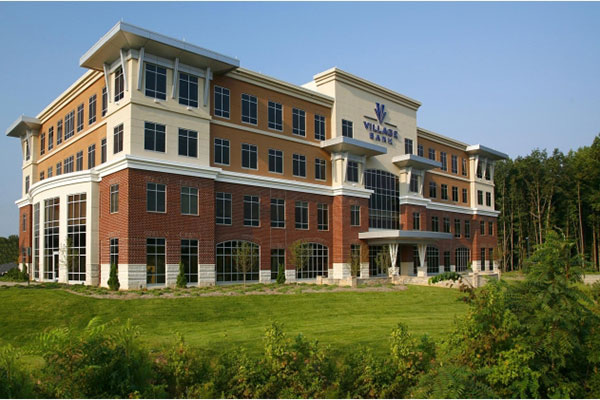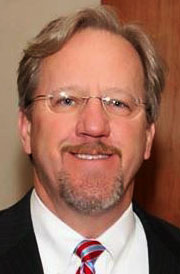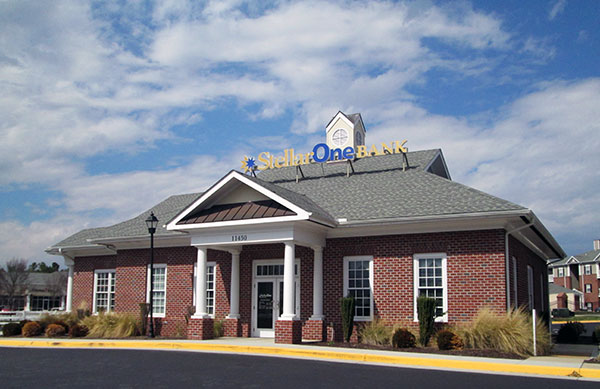
The Village Bank headquarters on Midlothian Turnpike. (Courtesy of CBRE)
In need of some extra capital, a local bank looked to its top dogs for a shot in the arm.
Midlothian-based Village Bank this month raised $1.68 million through a private placement to the members of its executive ranks and board of directors.
The insiders bought a total of 1.08 million shares of the bank’s common stock at $1.55 per share.
President and chief operating officer Bill Foster said Village had 100 percent participation from its board and top executives.

Bill Foster
“I’m in at $125,000 personally, so it’s a vote of confidence from everybody,” said Foster, who will in February become chief executive, succeeding longtime leader Tom Winfree.
Winfree bought in on the capital raise at 40,000 shares for a total of $62,000, according to SEC filings. The average investment made by directors in the capital raise was about $122,000, Foster said.
Foster said the bank looked to a private placement with insiders, rather than a large scale public stock offering, in an attempt to avoid diluting the stock owned by its loyal shareholders.
“The smarter thing to do is these series of small steps,” he said.
Although the raise shows investors that management and directors are in it for the long haul, the move also helps Village reach and maintain capital levels as set by regulatory oversight agreements.
The bank has been under written agreements with state and federal regulators for more than a year. The arrangement set goals the bank must meet to move toward more stable ground.
“It wasn’t just symbolic,” Foster said of the capital raise. “Obviously, we need to continue to build capital over time.”
In addition to finding extra capital, the $459 million bank has taken steps to cut expenses and curtail problematic loans.
Soured real estate loans and foreclosed properties, known as non-performing assets, have fueled the bank’s losses over the past few years.
Village reported $42.14 million in non-performing assets as of Sept. 30. That’s down from $61.33 million at the same point last year. Those non-performing assets account for 9.2 percent of the bank’s total assets. That percentage is down from 12.1 last year.

Village sold its location at 11450 Robious Road to StellarOne. (Photo by Michael Schwartz)
“We want 2014 to be the year we can get to the end of it and say ‘that’s not our number one priority anymore,’” Foster said of non-performing assets.
Other cost-cutting measures included selling the Village branch at 11450 Robious Road this year to StellarOne Bank. The branch sold for $1.67 million, according to Chesterfield County records. Village recorded a gain of $598,000 from the deal, according to its SEC filings.
Village also saw its TARP shares come under new ownership following an auction by the U.S. Treasury Dept. The bank received $14.7 million in TARP capital in 2009, in exchange for 14,738 shares of its preferred stock. Those shares were sold at a steep discount in November to private investors.
Foster said moving the shares from the political realm into the arms of business people should help the bank.
“It’s now in the hands of people who really are just trying to make a return and approach it as a business investor,” he said. “We view that as positive.”
The bank’s holding company, Village Bank and Trust Financial Corp., reported a loss of $488,357 in the third quarter. It lost $853,000 through the first nine months of the year, a vast improvement from the $12.1 million loss reported in the same period of 2012.

The Village Bank headquarters on Midlothian Turnpike. (Courtesy of CBRE)
In need of some extra capital, a local bank looked to its top dogs for a shot in the arm.
Midlothian-based Village Bank this month raised $1.68 million through a private placement to the members of its executive ranks and board of directors.
The insiders bought a total of 1.08 million shares of the bank’s common stock at $1.55 per share.
President and chief operating officer Bill Foster said Village had 100 percent participation from its board and top executives.

Bill Foster
“I’m in at $125,000 personally, so it’s a vote of confidence from everybody,” said Foster, who will in February become chief executive, succeeding longtime leader Tom Winfree.
Winfree bought in on the capital raise at 40,000 shares for a total of $62,000, according to SEC filings. The average investment made by directors in the capital raise was about $122,000, Foster said.
Foster said the bank looked to a private placement with insiders, rather than a large scale public stock offering, in an attempt to avoid diluting the stock owned by its loyal shareholders.
“The smarter thing to do is these series of small steps,” he said.
Although the raise shows investors that management and directors are in it for the long haul, the move also helps Village reach and maintain capital levels as set by regulatory oversight agreements.
The bank has been under written agreements with state and federal regulators for more than a year. The arrangement set goals the bank must meet to move toward more stable ground.
“It wasn’t just symbolic,” Foster said of the capital raise. “Obviously, we need to continue to build capital over time.”
In addition to finding extra capital, the $459 million bank has taken steps to cut expenses and curtail problematic loans.
Soured real estate loans and foreclosed properties, known as non-performing assets, have fueled the bank’s losses over the past few years.
Village reported $42.14 million in non-performing assets as of Sept. 30. That’s down from $61.33 million at the same point last year. Those non-performing assets account for 9.2 percent of the bank’s total assets. That percentage is down from 12.1 last year.

Village sold its location at 11450 Robious Road to StellarOne. (Photo by Michael Schwartz)
“We want 2014 to be the year we can get to the end of it and say ‘that’s not our number one priority anymore,’” Foster said of non-performing assets.
Other cost-cutting measures included selling the Village branch at 11450 Robious Road this year to StellarOne Bank. The branch sold for $1.67 million, according to Chesterfield County records. Village recorded a gain of $598,000 from the deal, according to its SEC filings.
Village also saw its TARP shares come under new ownership following an auction by the U.S. Treasury Dept. The bank received $14.7 million in TARP capital in 2009, in exchange for 14,738 shares of its preferred stock. Those shares were sold at a steep discount in November to private investors.
Foster said moving the shares from the political realm into the arms of business people should help the bank.
“It’s now in the hands of people who really are just trying to make a return and approach it as a business investor,” he said. “We view that as positive.”
The bank’s holding company, Village Bank and Trust Financial Corp., reported a loss of $488,357 in the third quarter. It lost $853,000 through the first nine months of the year, a vast improvement from the $12.1 million loss reported in the same period of 2012.


